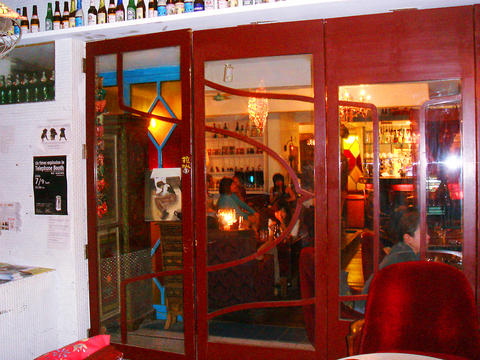Barbie and Angel are globe trotters whose travels to exotic locales are more like pilgrimages than sightseeing trips. Three years ago, the two Taipei girls visited Pushkar, India, and were inspired by the Hindu holy city's temples and shops.
"We saw a lot of foreigners in Pushkar, and we felt very comfortable in the shops there," Barbie told the Taipei Times. "We wanted to open up a restaurant with a similar feel in Taipei."
The result: The Peacock.

PHOTO: MAX HIRSCH, TAIPEI TIMES
The Shida night market bar and restaurant boasts a menu that is as eclectic as its decor. And behind the bistro's French doors, a dimly lit lounge that could pass for a set on That '70s Show enchants diners with its retro feel and twilight lighting.
Angel's touch -- besides her haunting paintings -- is the tasty Italian cuisine, which she learned to cook while running an Italian bistro before she opened the Peacock with Barbie. The two also traveled to Goa, India, to learn how to make Indian cuisine from a master chef. That pilgrimage resulted in their adding Tandoori lamb, as well as lamb and chicken masala dishes to the menu.
From vegetarian dishes, appetizers, entrees, to beers, wines, and cocktails, the Peacock has something for everybody. The pizzas are especially popular with diners, Barbie said. Smokers can taste a Hookah pipe -- a Middle Eastern "bong" with a long tube through which users inhale tobacco smoke. At the Peacock, smokers can sample a variety of flavored tobacco. Ever wonder what strawberry, peach, or cherry-flavored Hookah tobacco tastes like? Well, if you do, you don't have to go to Pakistan or Turkey to find out.
Whether on your food or in your lungs, the Peacock's exotic herbs make for a memorable outing. For diners more interested in conventional Western food, however, they won't be disappointed. Plenty of less adventurous dishes and beverages keep traditional tastebuds happy.
What may make diners a bit unhappy, though, is the quality of service, which is sometimes slack. You may have to fetch your own napkin or a water pitcher at peak hours, but a little patience will see you through. The bistro's laidback ambiance, complete with the hippest tunes around, keeps diners comfortable and engaged. Free wireless Internet service and a downstairs parlor for large groups are also plusses. A newly built enclosed front porch is open to customers who prefer to nurse a cocktail or eat a meal outside.

Oct. 27 to Nov. 2 Over a breakfast of soymilk and fried dough costing less than NT$400, seven officials and engineers agreed on a NT$400 million plan — unaware that it would mark the beginning of Taiwan’s semiconductor empire. It was a cold February morning in 1974. Gathered at the unassuming shop were Economics minister Sun Yun-hsuan (孫運璿), director-general of Transportation and Communications Kao Yu-shu (高玉樹), Industrial Technology Research Institute (ITRI) president Wang Chao-chen (王兆振), Telecommunications Laboratories director Kang Pao-huang (康寶煌), Executive Yuan secretary-general Fei Hua (費驊), director-general of Telecommunications Fang Hsien-chi (方賢齊) and Radio Corporation of America (RCA) Laboratories director Pan
The consensus on the Chinese Nationalist Party (KMT) chair race is that Cheng Li-wun (鄭麗文) ran a populist, ideological back-to-basics campaign and soundly defeated former Taipei mayor Hau Lung-bin (郝龍斌), the candidate backed by the big institutional players. Cheng tapped into a wave of popular enthusiasm within the KMT, while the institutional players’ get-out-the-vote abilities fell flat, suggesting their power has weakened significantly. Yet, a closer look at the race paints a more complicated picture, raising questions about some analysts’ conclusions, including my own. TURNOUT Here is a surprising statistic: Turnout was 130,678, or 39.46 percent of the 331,145 eligible party

The classic warmth of a good old-fashioned izakaya beckons you in, all cozy nooks and dark wood finishes, as tables order a third round and waiters sling tapas-sized bites and assorted — sometimes unidentifiable — skewered meats. But there’s a romantic hush about this Ximending (西門町) hotspot, with cocktails savored, plating elegant and never rushed and daters and diners lit by candlelight and chandelier. Each chair is mismatched and the assorted tables appear to be the fanciest picks from a nearby flea market. A naked sewing mannequin stands in a dimly lit corner, adorned with antique mirrors and draped foliage

The election of Cheng Li-wun (鄭麗文) as chair of the Chinese Nationalist Party (KMT) marked a triumphant return of pride in the “Chinese” in the party name. Cheng wants Taiwanese to be proud to call themselves Chinese again. The unambiguous winner was a return to the KMT ideology that formed in the early 2000s under then chairman Lien Chan (連戰) and president Ma Ying-jeou (馬英九) put into practice as far as he could, until ultimately thwarted by hundreds of thousands of protestors thronging the streets in what became known as the Sunflower movement in 2014. Cheng is an unambiguous Chinese ethnonationalist,